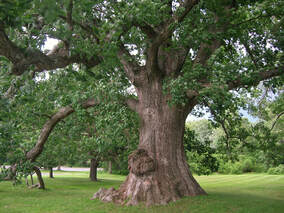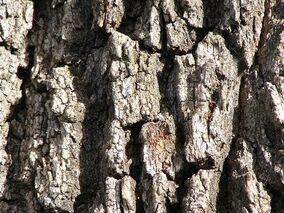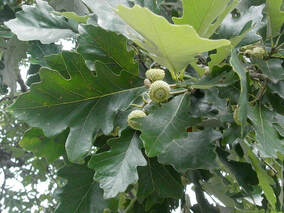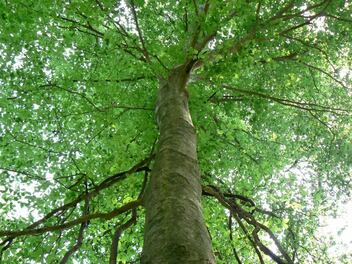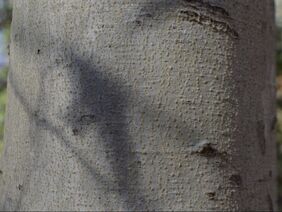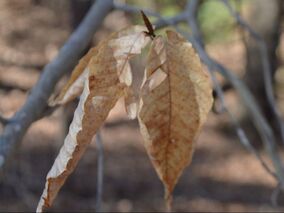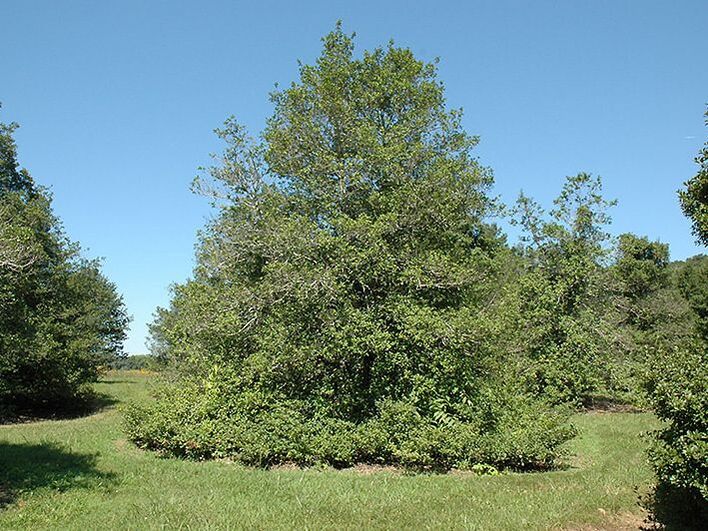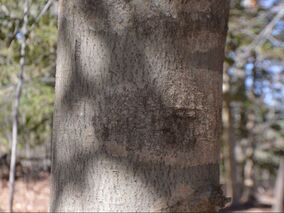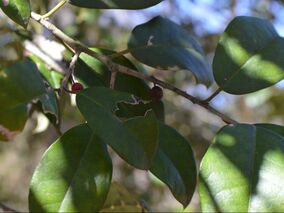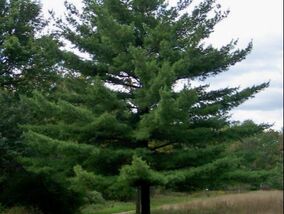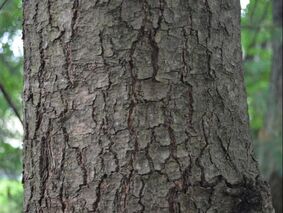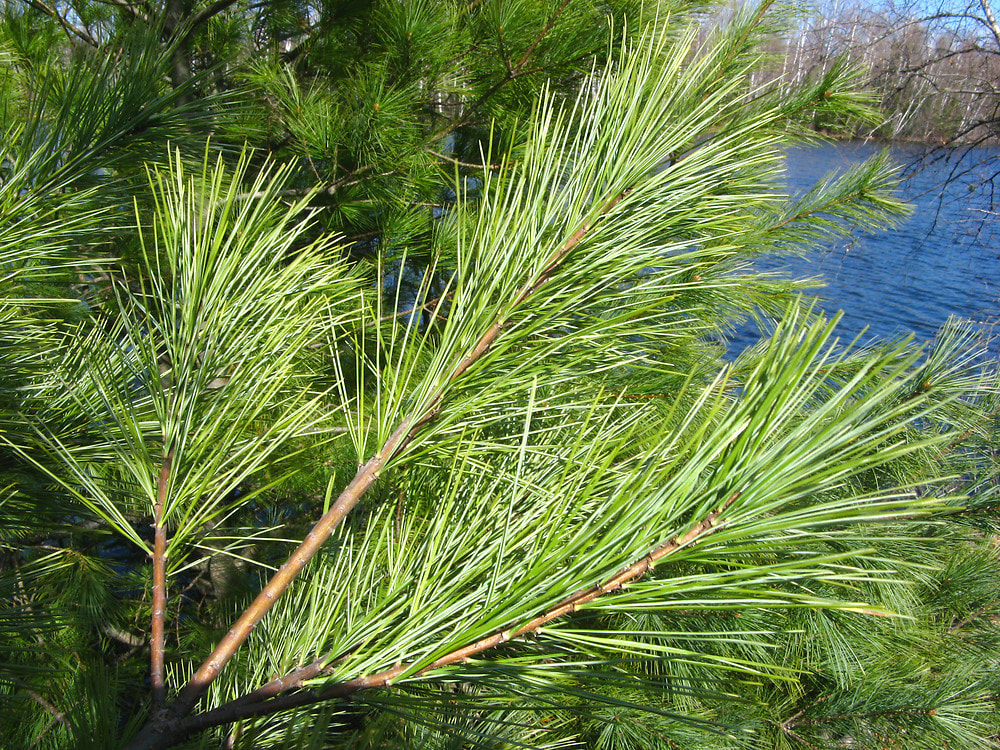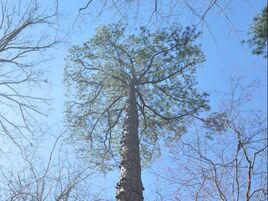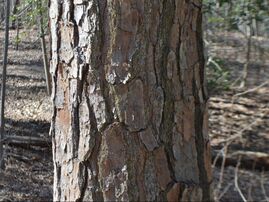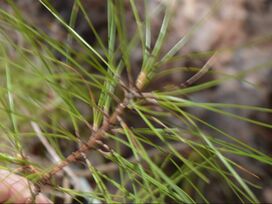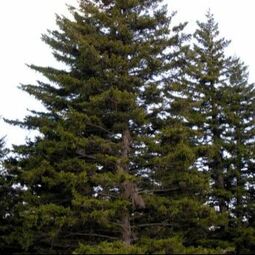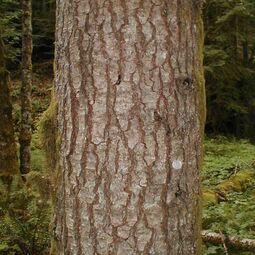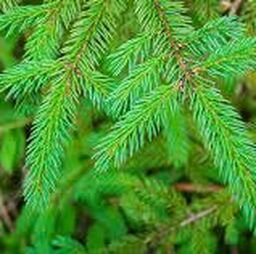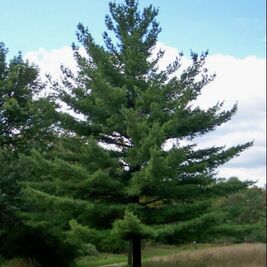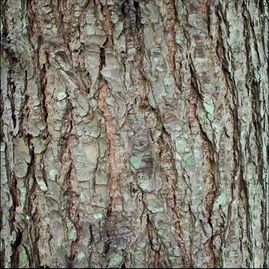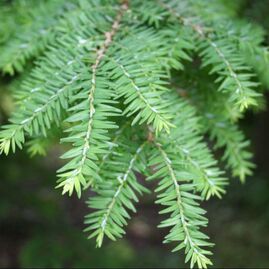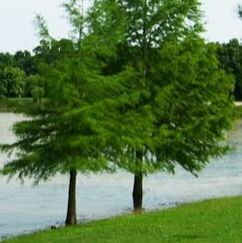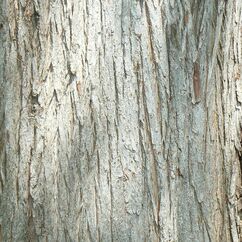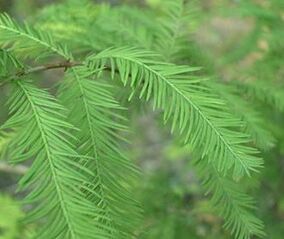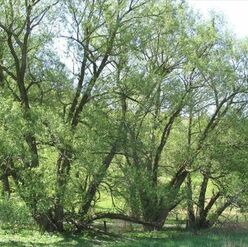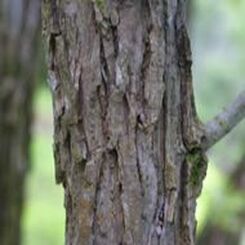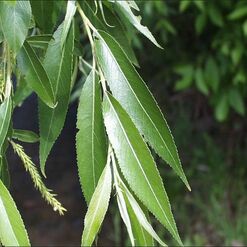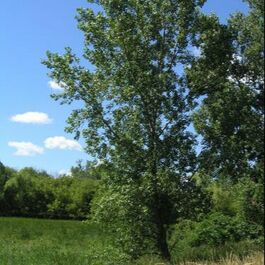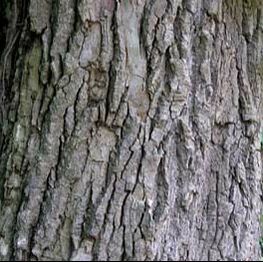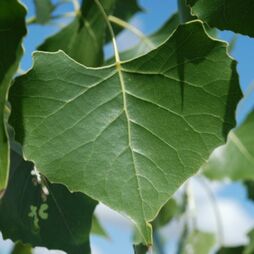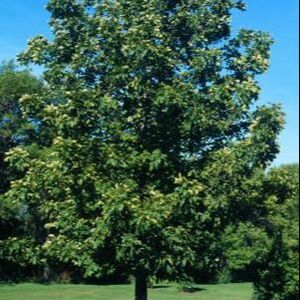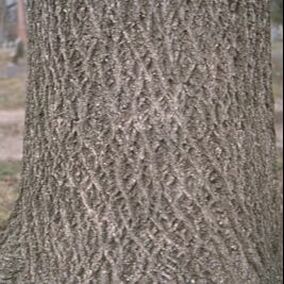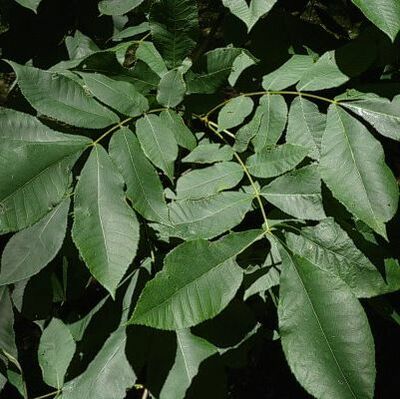trees: for the purpose of fire, fuel and construction
In this section you will find all the different Hardwood and Softwood trees that and their different uses for fuel, construction and other uses. We categorized it this way for the purpose of understanding when you would use hardwoods or softwoods depending on the purpose. Whether it is what kind of fire you need, what kind of shelter you are building, if you want to make cordage or a pitch from resin, this page will help you understand that.
Hard Woods
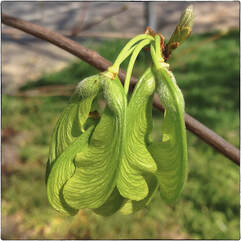
Hardwoods are angiosperm trees, which refers to one of the typical characteristics of this group, namely, that the seed has two embryonic leaves and the trees produce seeds within an enclosure like this picture of an Oak tree seedling. In other words, they are considered a fruiting plant. Hardwoods grow slower than Softwoods and can be seen through the growth rings. The smaller and more condensed the ring growth, the slower the tree has grown in its lifetime. Hardwoods are also the best to use for firewood that you need to burn for long periods of time.
BEECH FAMILY-FAGACEAE
White Oak
Latin Name: Quercus alba
Bark:
- A good source of tannin. Oak galls are excrescences that are sometimes produced in great numbers on the tree and are caused by the activity of the larvae of different insects. The insects live inside these galls, obtaining their nutrient therein. When the insect pupates and leaves, the gall can be used as a rich source of tannin, that can also be used as a dyestuff. A brown dye is obtained from the bark or from the galls, it does not require a mordant. Yellow, chrome and gold can also be obtained if mordants are used.
- Wood - strong, very heavy, hard, tough, close grained, durable. It weighs about 46lb per cubic foot. One of the most important timbers in N. America, it is used for cabinet making, construction, agricultural tools etc, and is also a good fuel. Highly valued for making the staves of barrels for storing wine and liquor.
Native To: North to East Central Minnesota to South Ontario and extreme South Quebec, East Texas to North Florida
Elevation: to 5,500 ft.
Elevation: to 5,500 ft.
American Beech
Latin Name: Fagus grandifolia
Seeds: The oil obtained from the seed can be used as a fuel source for lamps.
Bark: Makes an excellent charcoal and can be used for drawing.
Bark: Makes an excellent charcoal and can be used for drawing.
Native To: North Michigan to South of Ontario, East to Cape Breton Island,West East Texas South to North Florida
Elevation: to 3,000 or 6,000 ft.
Elevation: to 3,000 or 6,000 ft.
HOLLY FAMILY-AQUIFOLIACEAE
American Holly
Latin Name: Ilex opaca
Berries: Although these berries are poisonous, they can still be used to make a dye.
Wood: Great for carving tool handles and other smaller items.
Wood: Great for carving tool handles and other smaller items.
Native To: East of Massachusetts South to Central Florida, West to South Central Texas and North to Southeast Missouri
Elevation: to 3,000 or 4,000 ft.
Elevation: to 3,000 or 4,000 ft.
Soft Woods
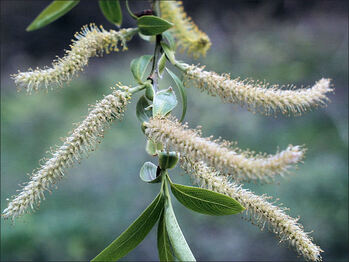
Softwoods are gymnosperm trees, literally meaning "naked seeds". The name comes from the concept that the seeds are not covered but rather are found in an open and exposed condition like you can see in this Black Willow seedling pictured here. Softwoods are easy to identify as they grow quickly and their growth rings are more spread out. Softwoods are best used for when you need to have a hotter or quicker burn such as a short term cook fire. Knowing that Softwoods don't bear fruit or flowers will help you identify the type of tree it is when you are out in the woods. Another sign of a Softwood are the conifers, which have the common presence of green leaves all year round, specifically those in the Pine Family. However, don't think all green-leaved trees are softwoods. There are also some from the angiosperm trees that are green all year round too.
PINE FAMILY-PINACEAE
Eastern White Pine
Latin Name: Pinus strobus
Useful Properties:
Fatwood: Pines are especially good for finding Resin-filled wood, whether they are dead or living trees. The base of the tree is the main areas in which the resin collects but you can also find it in lower limbs connected to the trunk. The closer to the trunk the better when cutting off the branch. You can tell you have found a nice resin-filled piece of wood when you can see a deep orange color in the wood and has a glossy and waxy look. Fatwood is perfect for using during inclement weather as it will burn even when wet due to the resin inside the wood.
Resin: Not only can you use the resin-filled wood for burning but you can also extract the resin from the wood. To extract resin from the wood, put the wood in a metal can with a hole for the resin to drain out of. Then put it over heat to cause the resin to release and drain out of the wood and then you can store it for other purposes. The pine resin can then be used for numerous things such as pine pitch, turpentine. glue, soap and medicinal use. (Check out our medicinal section of trees for pine resin and our How-to section under Bushcraft Education.)
Resin: Not only can you use the resin-filled wood for burning but you can also extract the resin from the wood. To extract resin from the wood, put the wood in a metal can with a hole for the resin to drain out of. Then put it over heat to cause the resin to release and drain out of the wood and then you can store it for other purposes. The pine resin can then be used for numerous things such as pine pitch, turpentine. glue, soap and medicinal use. (Check out our medicinal section of trees for pine resin and our How-to section under Bushcraft Education.)
Native To: Coastal Plain from Southeast Virginia to East Florida and West to East Texas
Elevation: 600 ft to 2,000 ft.
Elevation: 600 ft to 2,000 ft.
longleaf pine
Latin Name: Pinus palustris
Useful Properties:
Fatwood: Fatwood resins can be found and collected on dead fallen trees as well as living of all species of Pinaceae or trees of the The Pine Family. The main areas in which the resin collects is at the trees base, but you can also find them in the lower limbs mainly the areas which are connected to the trunk and extending outward. The closer to the trunk the better when cutting the branch off. You can tell you have a nice resin collection when you see a deep orange color and the wood has a glossy and waxy look. Fatwood is perfect for using during inclement weather as it will burn even when wet do to the resins inside the wood.
Resin: Not only can you use the resin filled wood but you can also extract the resin from the wood. By putting the wood in a metal can and burning the can underneath while leaving a whole for the resin to drain out so you can store the resin by itself for later use. The pines resin once extracted can be used to later create what is known as pine pitch.
Resin: Not only can you use the resin filled wood but you can also extract the resin from the wood. By putting the wood in a metal can and burning the can underneath while leaving a whole for the resin to drain out so you can store the resin by itself for later use. The pines resin once extracted can be used to later create what is known as pine pitch.
Native To: Coastal Plain from Southeast Virginia to East Florida and West to East Texas
Elevation: 600 ft to 2,000 ft.
Elevation: 600 ft to 2,000 ft.
Red Spruce
Latin Name: Picea rubens
Useful Properties:
Bark: Used to make baskets.
Pitch: Sap mixed with charcoal:
Roots: Used to make thread for sewing baskets, canoe skins etc.
Wood Pulp:. Used to make paper and is commonly used to produce stringed musical instruments.
Pitch: Sap mixed with charcoal:
Roots: Used to make thread for sewing baskets, canoe skins etc.
Wood Pulp:. Used to make paper and is commonly used to produce stringed musical instruments.
Native To: Southeast Manitoba East to Nova Scotia, South to Pennsylvania and West of Minnesota, Local in Newfoundland, North Illinois and East West Virginia
Elevation: at 700 ft to 1,400 ft northward to 2,700 in Adirondacks and 3,800 to 4,300 in West Virginia
Elevation: at 700 ft to 1,400 ft northward to 2,700 in Adirondacks and 3,800 to 4,300 in West Virginia
Eastern hemlock
Latin Name: Tsuga canadensis
Useful Properties:
Bark: Can be used for its tannin or tannic acid which can be used for tanning leather, dyeing fabric or making ink.
Branches: Can be used to create brooms
Branches: Can be used to create brooms
Native To: South Ontario East to Cape Breton Island, South in mountains to North Alabama and West to East Minnesota
Elevation: to 3,000 ft North at 2,000 ft. to 5,000 ft South
Elevation: to 3,000 ft North at 2,000 ft. to 5,000 ft South
Redwood family-Taxodiaceae
Bald Cypress
Latin Name: Taxodium distichum
Useful Properties:
Bark: Use to make cordage.
Native To: South Delaware to South Florida, West to South Texas and North to Southeast Oklahoma and Southwest Indiana
Elevation: Below 500 ft to 1,700 ft.
Elevation: Below 500 ft to 1,700 ft.
Willow family-Salicaceae
Black Willow
Latin Name: Salix nigra
Useful Properties:
Stems: Young stems are very flexible and can be used in basket and furniture making.
Twigs: Can be split in half lengthwise, sun-dried and used as the foundation of coiled basketry.
Fibers: A fibers obtained from the stems can be used in making paper. The stems are harvested in spring or summer, the leaves are removed and the stems steamed until the fibers can be stripped. The fibers are cooked for 2 hours with lye and then beaten with mallets or put through a blender. The paper is red/brown in color
Bark: Is a good source of tannin. A decoction or infusion of the bark can be used as a hair wash to make the hair grow.
Branches: Great source for making bow-drills as the wood is soft and great for making embers..
Fuel Use: A good charcoal is also obtained from the wood.
Twigs: Can be split in half lengthwise, sun-dried and used as the foundation of coiled basketry.
Fibers: A fibers obtained from the stems can be used in making paper. The stems are harvested in spring or summer, the leaves are removed and the stems steamed until the fibers can be stripped. The fibers are cooked for 2 hours with lye and then beaten with mallets or put through a blender. The paper is red/brown in color
Bark: Is a good source of tannin. A decoction or infusion of the bark can be used as a hair wash to make the hair grow.
Branches: Great source for making bow-drills as the wood is soft and great for making embers..
Fuel Use: A good charcoal is also obtained from the wood.
Native To: Southeast Minnesota to Maine, South Texas to South New Brunswick, North California to West Texas
Elevation: to 5,000 ft.
Elevation: to 5,000 ft.
Eastern Cottonwood
Latin Name: Populus deltoides
Useful Properties:
Leaves: Various dyes can be obtained from the leaf buds in the spring - green, white, yellow, purple and red.
Wood: The wood has been used as a bio-mass for producing methanol, which can be used to power internal combustion engines.
Wood: The wood has been used as a bio-mass for producing methanol, which can be used to power internal combustion engines.
Native To: North Central Montana to South Alberta to extreme South Quebec and New Hampshire, West Texas to South to Northwest Florida
Elevation: to 1,o00 ft East to 5,000 ft. West
Elevation: to 1,o00 ft East to 5,000 ft. West
bitternut hickory
Latin Name: Carya cordiformis
Useful Properties:
Seeds: An oil can be expressed from the seeds and can be used to illuminate in lamps.
Wood: Although the wood tends to be brittle, it has an amazing quality of shock-resistance and is used for hoops, tool handles etc, though it is considered to be inferior to other hickories.
Fuel Use: Burns well and gives off a lot of heat.
Wood: Although the wood tends to be brittle, it has an amazing quality of shock-resistance and is used for hoops, tool handles etc, though it is considered to be inferior to other hickories.
Fuel Use: Burns well and gives off a lot of heat.
Native To: South Quebec and Southwest New Hampshire, South to Northwest Florida, West to East Texas, and North to Minnesota
Elevation: to 2,o00 ft
Elevation: to 2,o00 ft
